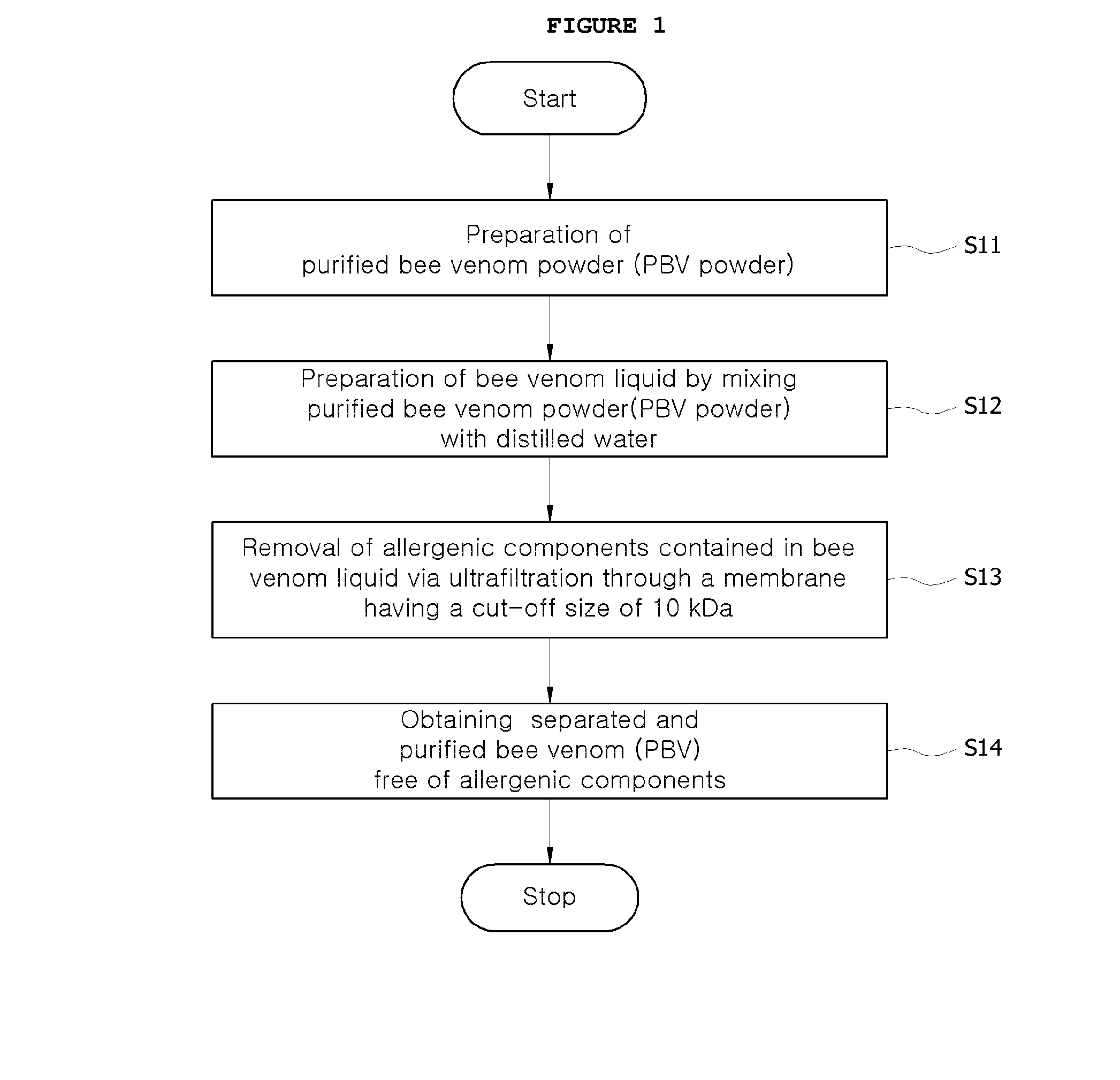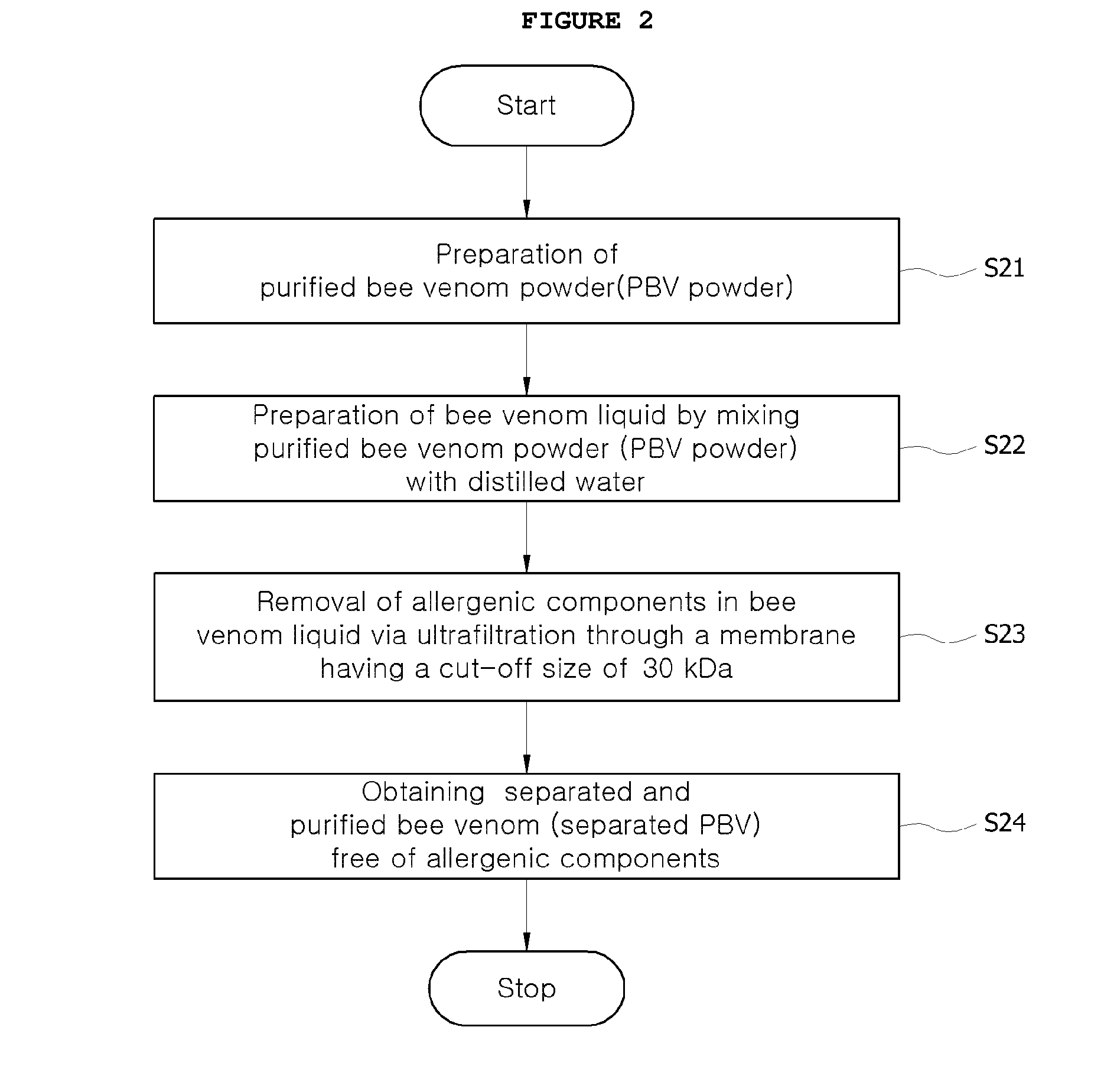Preparation of bee venom with allergenic components removed
a technology of bee venom and purification method, which is applied in the field of purification method of bee venom, can solve the problems of limiting the physiological effect of bee venom, serious safety issues, and the method fails to include a step to remove phospholipase, so as to reduce phospholipase to the maximum, improve the yield of separated pbv, and avoid allergic reactions.
- Summary
- Abstract
- Description
- Claims
- Application Information
AI Technical Summary
Benefits of technology
Problems solved by technology
Method used
Image
Examples
example 2
1) Preparation of PBV Powder
[0064]PBV powder was prepared in the same manner as in Example 1.
2) Separation of Allergic Ingredients
[0065]The PBV powder prepared previously was mixed with distilled water, purified via filtration through a 0.2 μm membrane filter, in a ratio of 1:100 (g / mL) to obtain a bee venom liquid.
[0066]Then, the bee venom liquid was filtered through an ultrafiltration membrane (Ultracel PL regenerated cellulose, 76 mm) with a cut-off size of 30 kDa using Millipore series 8400 stirred cells to remove allergenic components thereby obtaining a separated PBV. Here, the filtration was performed until the bee venom liquid contained in the cells was concentrated to a final volume of about from 5 mL to 10 mL under the pressure of 0.4 MPa.
[0067]The thus obtained separated PBV was dried into powder via lyophilization.
experimental example 1
Electrophoresis Experiment
[0068]18% or 20% gel composition ((i) 18% gel composition consisting of 1.3 mL of distilled water, 6.0 mL of 30% acrylamide mix, 2.5 mL of 1.5 tris(hydroxymethyl)aminomethane-HCl (Tris-HCl) (pH8.8), 100 μL of 10% sodium dodecyl sulfate (SDS), 100 μL of 10% ammonium persulfate, and 4 μL of tetramethylethylenediamine (TEMED); and (ii) 20% gel composition consisting of 700 μL of distilled water, 6.6 mL of 30% acrylamide mix, 2.5 mL of 1.5 M Tris-HCl (pH8.8), 100 μL of 10% SDS, 100 μL of 10% ammonium persulfate, and 4 μL of TEMED) were prepared, and 10 mL each of the gel compositions was aliquoted onto a glass plate.
[0069]Upon equilibration, a separating gel was solidified, and then, about 5 mL of a stacking gel composition (consisting of 3.4 mL of distilled water, 830 μL of 30% acrylamide mix, 630 μL of 1.5 M Tris-HCl (pH 8.8), 50 μL of 10% SDS, 50 μL of 10% ammonium persulfate, and 5 μL of TEMED) was aliquoted. The gel was solidified after inserting a comb th...
experimental example 2
HPLC Quantitative Analysis
[0076]The separated PBVs of Examples 1 and 2 were respectively prepared into a concentration of 1.0 mg / mL, and analyzed via high-performance liquid chromatography (HPLC) apparatus using a peptide analysis column (150×4.6 mm 4.0 μm, 90, Phenomenex®) along with water for HPLC (0.2% TFA in water), and acetonitrile (0.22% TFA in ACN) as a solvent.
[0077]FIG. 4 is a graph showing a result of HPLC analysis of the separated PBVs according to Experimental Example 2 of the present invention.
[0078]As a result of HPLC quantitative analysis, the components contained in each of the separated PBVs of Examples 1 and 2 were confirmed in comparison with those of the standard PBV, as shown in FIG. 4.
[0079]More specifically, an HPLC quantitative analysis result of the standard PBV revealed that apamin and melittin had peaks at 10.4 min and 21.3 min, respectively, and phospholipase A2(PLA2) had a peak at 16.3 min.
[0080]The area of a given peak can be used to calculate contents,...
PUM
 Login to View More
Login to View More Abstract
Description
Claims
Application Information
 Login to View More
Login to View More - R&D
- Intellectual Property
- Life Sciences
- Materials
- Tech Scout
- Unparalleled Data Quality
- Higher Quality Content
- 60% Fewer Hallucinations
Browse by: Latest US Patents, China's latest patents, Technical Efficacy Thesaurus, Application Domain, Technology Topic, Popular Technical Reports.
© 2025 PatSnap. All rights reserved.Legal|Privacy policy|Modern Slavery Act Transparency Statement|Sitemap|About US| Contact US: help@patsnap.com



